Abstract
This study examined the expression of epidermal growth factor (EGF) cell-surface receptors, the response to exogenous ligand and the autocrine production of transforming growth factor alpha (TGF-alpha) in normal and carcinoma-derived human oral keratinocytes. One of eight malignant cell lines overexpressed EGF receptors, while the remainder expressed receptor numbers similar to normal cells. Exogenous EGF stimulated incorporation of tritiated thymidine in a dose-dependent manner. In keratinocytes expressing normal numbers of EGF receptors, the cellular response to exogenous EGF correlated positively with total EGF receptor number. SCC-derived keratinocytes produced more TGF-alpha than normal cells. There was no statistical correlation between the autocrine production of TGF-alpha, EGF cell-surface receptor expression and cellular response to exogenous EGF. While the growth-stimulatory effects of exogenous TGF-alpha were inhibited by the addition of a neutralising antibody, the presence of this antibody in conditioned medium failed to produce a similar decrease in growth. The results indicate that overexpression of EGF receptors is not an invariable characteristic of human oral squamous carcinoma-derived cell lines. Further, the contribution of TGF-alpha to the growth of normal and carcinoma-derived human oral keratinocytes in vitro may be less significant than previously documented.
Full text
PDF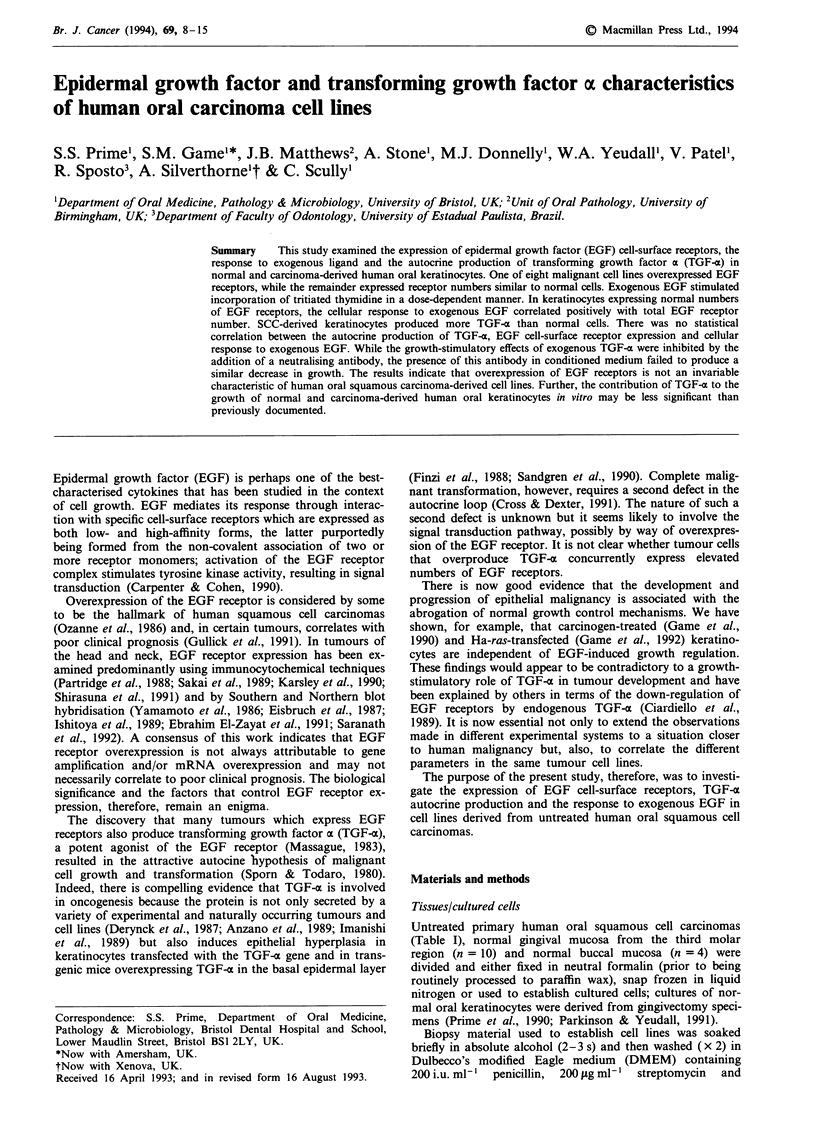
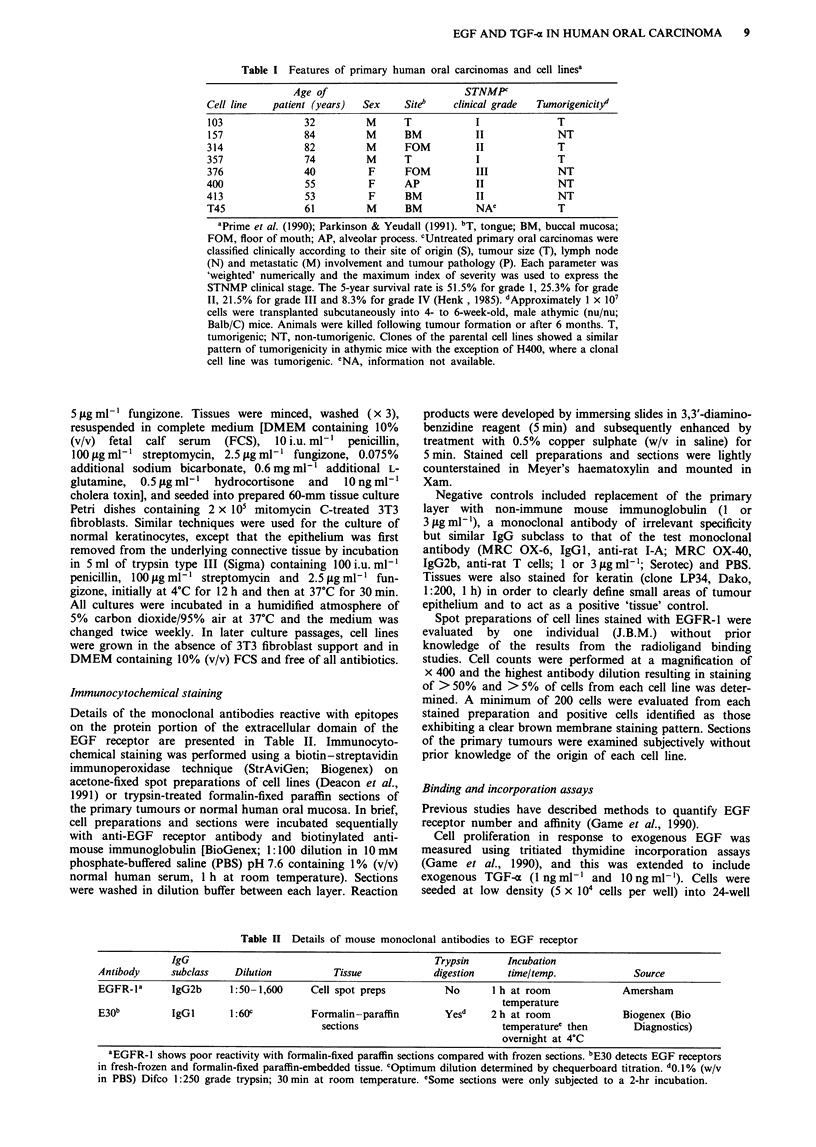
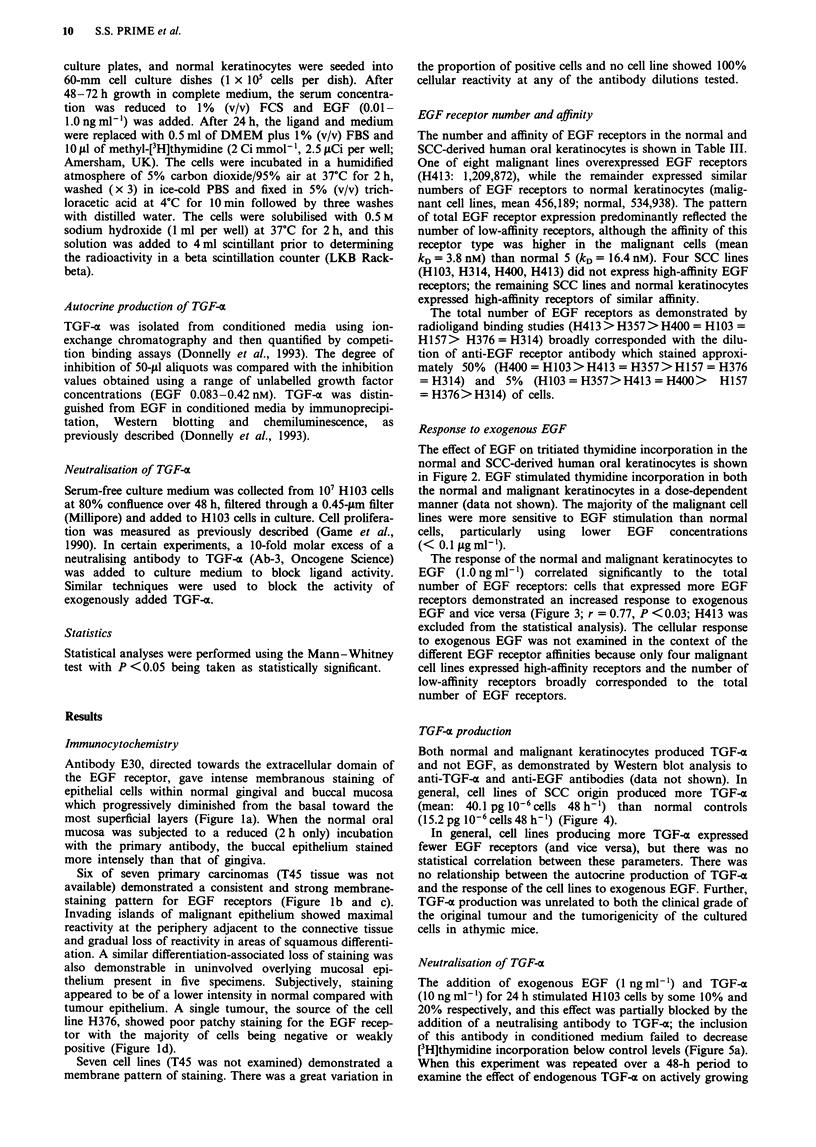
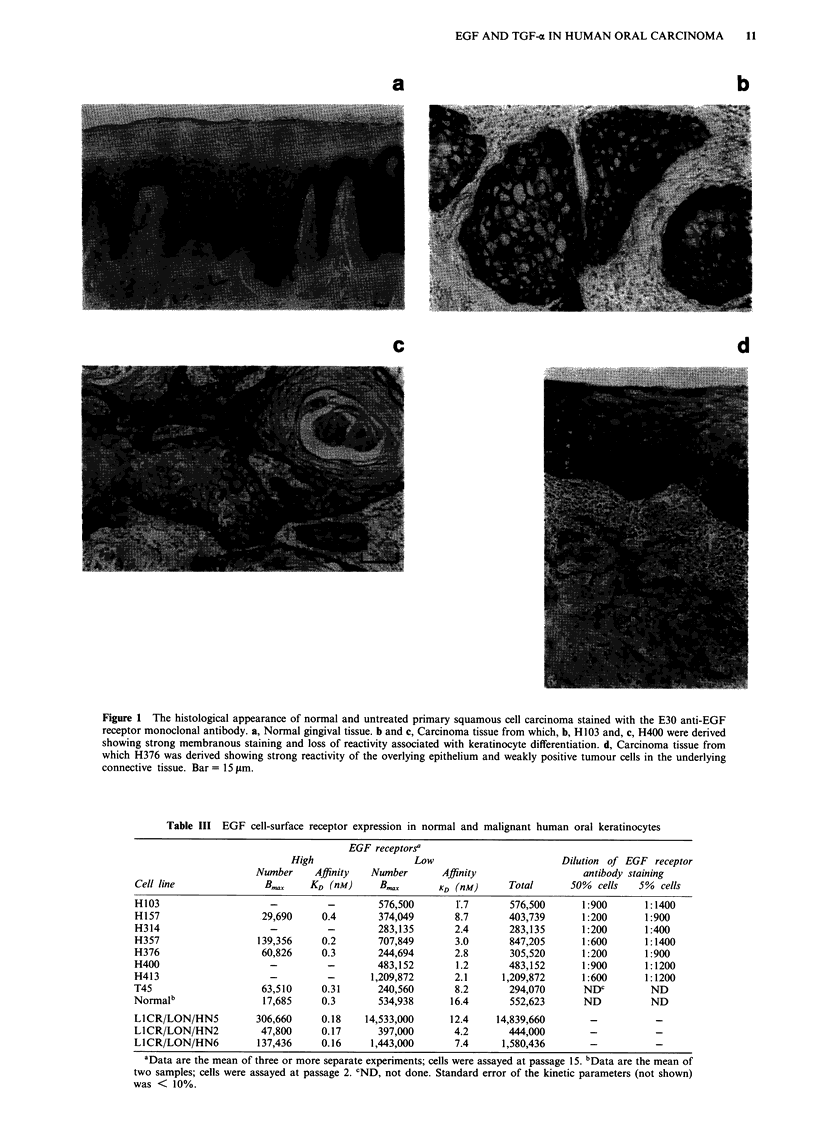

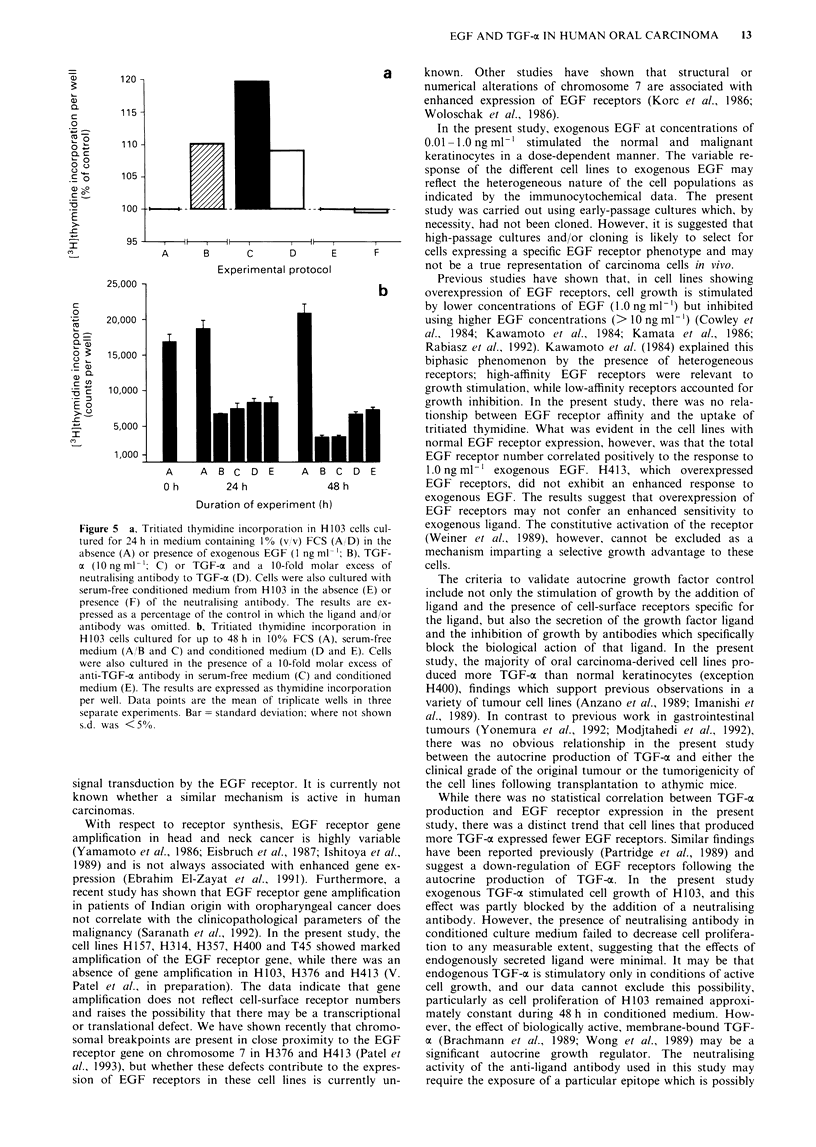
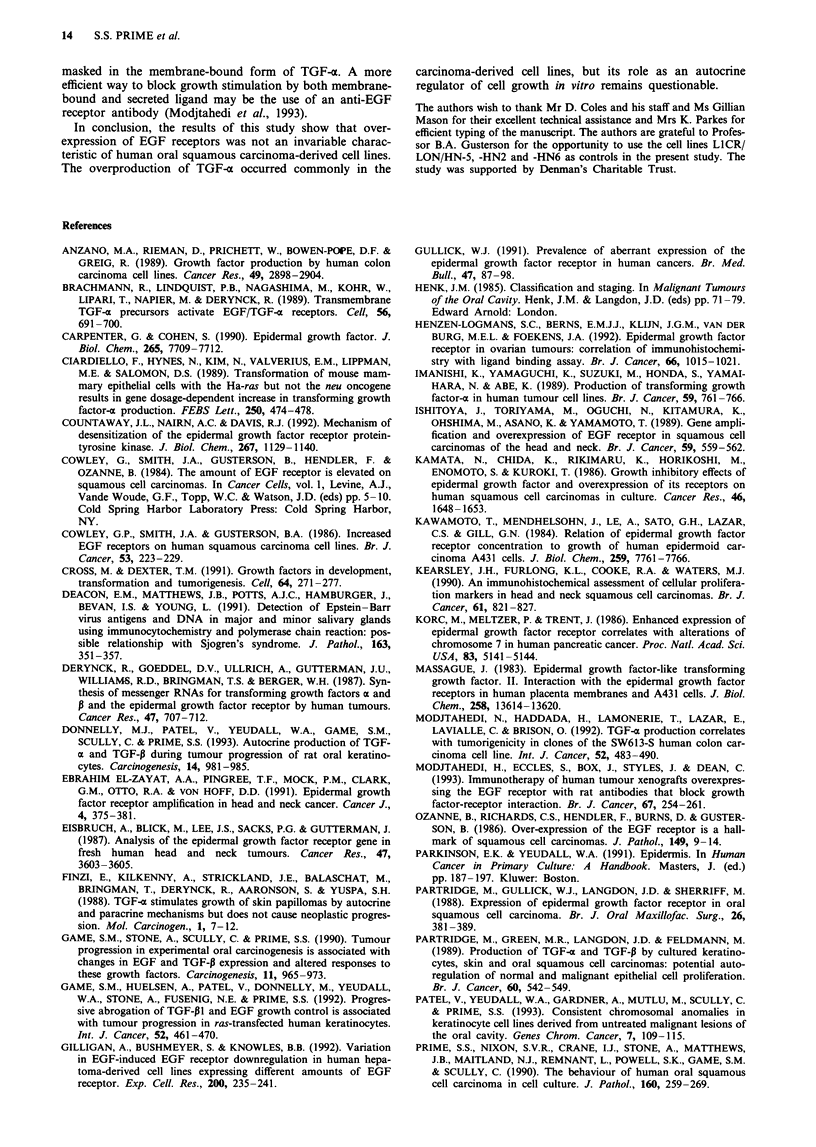
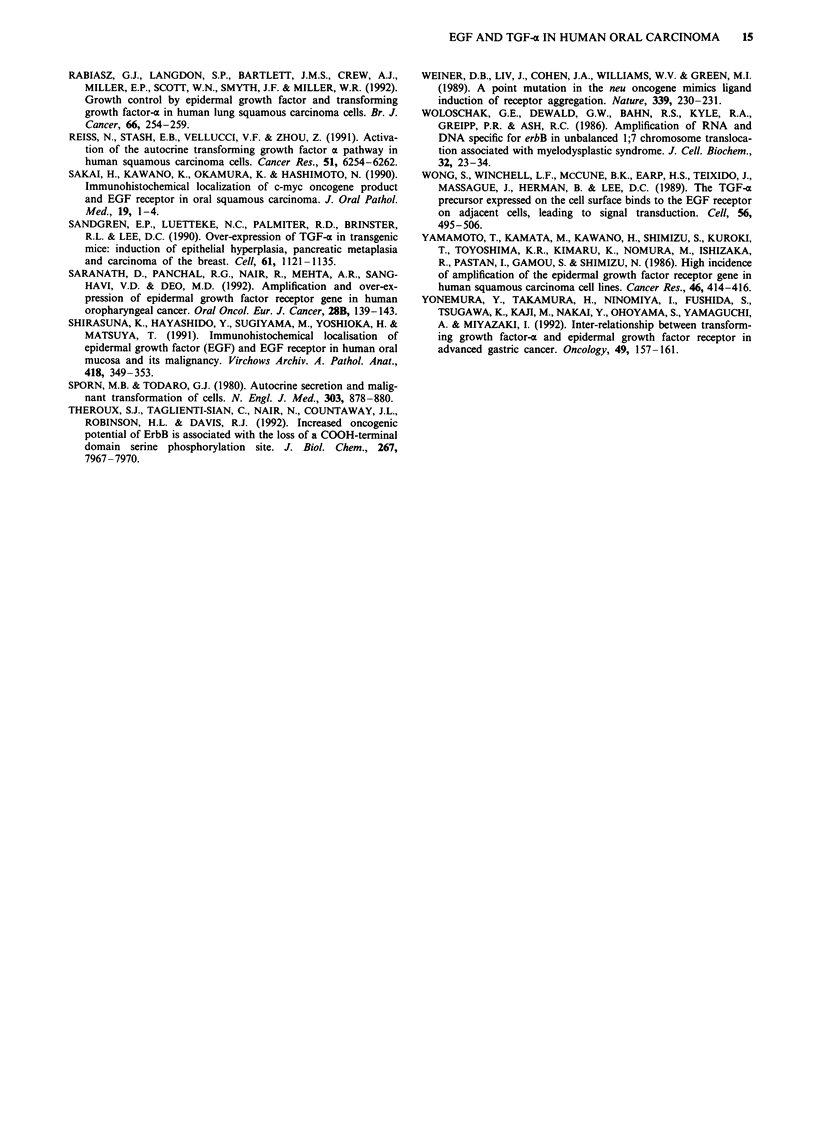
Images in this article
Selected References
These references are in PubMed. This may not be the complete list of references from this article.
- Anzano M. A., Rieman D., Prichett W., Bowen-Pope D. F., Greig R. Growth factor production by human colon carcinoma cell lines. Cancer Res. 1989 Jun 1;49(11):2898–2904. [PubMed] [Google Scholar]
- Brachmann R., Lindquist P. B., Nagashima M., Kohr W., Lipari T., Napier M., Derynck R. Transmembrane TGF-alpha precursors activate EGF/TGF-alpha receptors. Cell. 1989 Feb 24;56(4):691–700. doi: 10.1016/0092-8674(89)90591-6. [DOI] [PubMed] [Google Scholar]
- Carpenter G., Cohen S. Epidermal growth factor. J Biol Chem. 1990 May 15;265(14):7709–7712. [PubMed] [Google Scholar]
- Ciardiello F., Hynes N., Kim N., Valverius E. M., Lippman M. E., Salomon D. S. Transformation of mouse mammary epithelial cells with the Ha-ras but not with the neu oncogene results in a gene dosage-dependent increase in transforming growth factor-alpha production. FEBS Lett. 1989 Jul 3;250(2):474–478. doi: 10.1016/0014-5793(89)80779-3. [DOI] [PubMed] [Google Scholar]
- Countaway J. L., Nairn A. C., Davis R. J. Mechanism of desensitization of the epidermal growth factor receptor protein-tyrosine kinase. J Biol Chem. 1992 Jan 15;267(2):1129–1140. [PubMed] [Google Scholar]
- Cowley G. P., Smith J. A., Gusterson B. A. Increased EGF receptors on human squamous carcinoma cell lines. Br J Cancer. 1986 Feb;53(2):223–229. doi: 10.1038/bjc.1986.39. [DOI] [PMC free article] [PubMed] [Google Scholar]
- Cross M., Dexter T. M. Growth factors in development, transformation, and tumorigenesis. Cell. 1991 Jan 25;64(2):271–280. doi: 10.1016/0092-8674(91)90638-f. [DOI] [PubMed] [Google Scholar]
- Deacon E. M., Matthews J. B., Potts A. J., Hamburger J., Bevan I. S., Young L. S. Detection of Epstein-Barr virus antigens and DNA in major and minor salivary glands using immunocytochemistry and polymerase chain reaction: possible relationship with Sjogren's syndrome. J Pathol. 1991 Apr;163(4):351–360. doi: 10.1002/path.1711630413. [DOI] [PubMed] [Google Scholar]
- Derynck R., Goeddel D. V., Ullrich A., Gutterman J. U., Williams R. D., Bringman T. S., Berger W. H. Synthesis of messenger RNAs for transforming growth factors alpha and beta and the epidermal growth factor receptor by human tumors. Cancer Res. 1987 Feb 1;47(3):707–712. [PubMed] [Google Scholar]
- Donnelly M. J., Patel V., Yeudall W. A., Game S. M., Scully C., Prime S. S. Autocrine production of TGF-alpha and TGF-beta during tumour progression of rat oral keratinocytes. Carcinogenesis. 1993 May;14(5):981–985. doi: 10.1093/carcin/14.5.981. [DOI] [PubMed] [Google Scholar]
- Eisbruch A., Blick M., Lee J. S., Sacks P. G., Gutterman J. Analysis of the epidermal growth factor receptor gene in fresh human head and neck tumors. Cancer Res. 1987 Jul 1;47(13):3603–3605. [PubMed] [Google Scholar]
- Finzi E., Kilkenny A., Strickland J. E., Balaschak M., Bringman T., Derynck R., Aaronson S., Yuspa S. H. TGF alpha stimulates growth of skin papillomas by autocrine and paracrine mechanisms but does not cause neoplastic progression. Mol Carcinog. 1988;1(1):7–12. doi: 10.1002/mc.2940010105. [DOI] [PubMed] [Google Scholar]
- Game S. M., Huelsen A., Patel V., Donnelly M., Yeudall W. A., Stone A., Fusenig N. E., Prime S. S. Progressive abrogation of TGF-beta 1 and EGF growth control is associated with tumour progression in ras-transfected human keratinocytes. Int J Cancer. 1992 Sep 30;52(3):461–470. doi: 10.1002/ijc.2910520322. [DOI] [PubMed] [Google Scholar]
- Game S. M., Stone A., Scully C., Prime S. S. Tumour progression in experimental oral carcinogenesis is associated with changes in EGF and TGF-beta receptor expression and altered responses to these growth factors. Carcinogenesis. 1990 Jun;11(6):965–973. doi: 10.1093/carcin/11.6.965. [DOI] [PubMed] [Google Scholar]
- Gilligan A., Bushmeyer S., Knowles B. B. Variation in EGF-induced EGF receptor downregulation in human hepatoma-derived cell lines expressing different amounts of EGF receptor. Exp Cell Res. 1992 Jun;200(2):235–241. doi: 10.1016/0014-4827(92)90169-9. [DOI] [PubMed] [Google Scholar]
- Gullick W. J. Prevalence of aberrant expression of the epidermal growth factor receptor in human cancers. Br Med Bull. 1991 Jan;47(1):87–98. doi: 10.1093/oxfordjournals.bmb.a072464. [DOI] [PubMed] [Google Scholar]
- Henzen-Logmans S. C., Berns E. M., Klijn J. G., van der Burg M. E., Foekens J. A. Epidermal growth factor receptor in ovarian tumours: correlation of immunohistochemistry with ligand binding assay. Br J Cancer. 1992 Dec;66(6):1015–1021. doi: 10.1038/bjc.1992.403. [DOI] [PMC free article] [PubMed] [Google Scholar]
- Imanishi K., Yamaguchi K., Suzuki M., Honda S., Yanaihara N., Abe K. Production of transforming growth factor-alpha in human tumour cell lines. Br J Cancer. 1989 May;59(5):761–765. doi: 10.1038/bjc.1989.159. [DOI] [PMC free article] [PubMed] [Google Scholar]
- Ishitoya J., Toriyama M., Oguchi N., Kitamura K., Ohshima M., Asano K., Yamamoto T. Gene amplification and overexpression of EGF receptor in squamous cell carcinomas of the head and neck. Br J Cancer. 1989 Apr;59(4):559–562. doi: 10.1038/bjc.1989.113. [DOI] [PMC free article] [PubMed] [Google Scholar]
- Kamata N., Chida K., Rikimaru K., Horikoshi M., Enomoto S., Kuroki T. Growth-inhibitory effects of epidermal growth factor and overexpression of its receptors on human squamous cell carcinomas in culture. Cancer Res. 1986 Apr;46(4 Pt 1):1648–1653. [PubMed] [Google Scholar]
- Kawamoto T., Mendelsohn J., Le A., Sato G. H., Lazar C. S., Gill G. N. Relation of epidermal growth factor receptor concentration to growth of human epidermoid carcinoma A431 cells. J Biol Chem. 1984 Jun 25;259(12):7761–7766. [PubMed] [Google Scholar]
- Kearsley J. H., Furlong K. L., Cooke R. A., Waters M. J. An immunohistochemical assessment of cellular proliferation markers in head and neck squamous cell cancers. Br J Cancer. 1990 Jun;61(6):821–827. doi: 10.1038/bjc.1990.184. [DOI] [PMC free article] [PubMed] [Google Scholar]
- Korc M., Meltzer P., Trent J. Enhanced expression of epidermal growth factor receptor correlates with alterations of chromosome 7 in human pancreatic cancer. Proc Natl Acad Sci U S A. 1986 Jul;83(14):5141–5144. doi: 10.1073/pnas.83.14.5141. [DOI] [PMC free article] [PubMed] [Google Scholar]
- Massagué J. Epidermal growth factor-like transforming growth factor. II. Interaction with epidermal growth factor receptors in human placenta membranes and A431 cells. J Biol Chem. 1983 Nov 25;258(22):13614–13620. [PubMed] [Google Scholar]
- Modjtahedi H., Eccles S., Box G., Styles J., Dean C. Immunotherapy of human tumour xenografts overexpressing the EGF receptor with rat antibodies that block growth factor-receptor interaction. Br J Cancer. 1993 Feb;67(2):254–261. doi: 10.1038/bjc.1993.49. [DOI] [PMC free article] [PubMed] [Google Scholar]
- Modjtahedi N., Haddada H., Lamonerie T., Lazar E., Lavialle C., Brison O. TGF-alpha production correlates with tumorigenicity in clones of the SW613-S human colon carcinoma cell line. Int J Cancer. 1992 Sep 30;52(3):483–490. doi: 10.1002/ijc.2910520325. [DOI] [PubMed] [Google Scholar]
- Ozanne B., Richards C. S., Hendler F., Burns D., Gusterson B. Over-expression of the EGF receptor is a hallmark of squamous cell carcinomas. J Pathol. 1986 May;149(1):9–14. doi: 10.1002/path.1711490104. [DOI] [PubMed] [Google Scholar]
- Partridge M., Green M. R., Langdon J. D., Feldmann M. Production of TGF-alpha and TGF-beta by cultured keratinocytes, skin and oral squamous cell carcinomas--potential autocrine regulation of normal and malignant epithelial cell proliferation. Br J Cancer. 1989 Oct;60(4):542–548. doi: 10.1038/bjc.1989.310. [DOI] [PMC free article] [PubMed] [Google Scholar]
- Partridge M., Gullick W. J., Langdon J. D., Sherriff M. Expression of epidermal growth factor receptor on oral squamous cell carcinoma. Br J Oral Maxillofac Surg. 1988 Oct;26(5):381–389. doi: 10.1016/0266-4356(88)90090-3. [DOI] [PubMed] [Google Scholar]
- Patel V., Yeudall W. A., Gardner A., Mutlu S., Scully C., Prime S. S. Consistent chromosomal anomalies in keratinocyte cell lines derived from untreated malignant lesions of the oral cavity. Genes Chromosomes Cancer. 1993 Jun;7(2):109–115. doi: 10.1002/gcc.2870070208. [DOI] [PubMed] [Google Scholar]
- Prime S. S., Nixon S. V., Crane I. J., Stone A., Matthews J. B., Maitland N. J., Remnant L., Powell S. K., Game S. M., Scully C. The behaviour of human oral squamous cell carcinoma in cell culture. J Pathol. 1990 Mar;160(3):259–269. doi: 10.1002/path.1711600313. [DOI] [PubMed] [Google Scholar]
- Rabiasz G. J., Langdon S. P., Bartlett J. M., Crew A. J., Miller E. P., Scott W. N., Smyth J. F., Miller W. R. Growth control by epidermal growth factor and transforming growth factor-alpha in human lung squamous carcinoma cells. Br J Cancer. 1992 Aug;66(2):254–259. doi: 10.1038/bjc.1992.253. [DOI] [PMC free article] [PubMed] [Google Scholar]
- Reiss M., Stash E. B., Vellucci V. F., Zhou Z. L. Activation of the autocrine transforming growth factor alpha pathway in human squamous carcinoma cells. Cancer Res. 1991 Dec 1;51(23 Pt 1):6254–6262. [PubMed] [Google Scholar]
- Sakai H., Kawano K., Okamura K., Hashimoto N. Immunohistochemical localization of c-myc oncogene product and EGF receptor in oral squamous cell carcinoma. J Oral Pathol Med. 1990 Jan;19(1):1–4. doi: 10.1111/j.1600-0714.1990.tb00773.x. [DOI] [PubMed] [Google Scholar]
- Sandgren E. P., Luetteke N. C., Palmiter R. D., Brinster R. L., Lee D. C. Overexpression of TGF alpha in transgenic mice: induction of epithelial hyperplasia, pancreatic metaplasia, and carcinoma of the breast. Cell. 1990 Jun 15;61(6):1121–1135. doi: 10.1016/0092-8674(90)90075-p. [DOI] [PubMed] [Google Scholar]
- Saranath D., Panchal R. G., Nair R., Mehta A. R., Sanghavi V. D., Deo M. G. Amplification and overexpression of epidermal growth factor receptor gene in human oropharyngeal cancer. Eur J Cancer B Oral Oncol. 1992 Oct;28B(2):139–143. doi: 10.1016/0964-1955(92)90043-z. [DOI] [PubMed] [Google Scholar]
- Shirasuna K., Hayashido Y., Sugiyama M., Yoshioka H., Matsuya T. Immunohistochemical localization of epidermal growth factor (EGF) and EGF receptor in human oral mucosa and its malignancy. Virchows Arch A Pathol Anat Histopathol. 1991;418(4):349–353. doi: 10.1007/BF01600165. [DOI] [PubMed] [Google Scholar]
- Sporn M. B., Todaro G. J. Autocrine secretion and malignant transformation of cells. N Engl J Med. 1980 Oct 9;303(15):878–880. doi: 10.1056/NEJM198010093031511. [DOI] [PubMed] [Google Scholar]
- Theroux S. J., Taglienti-Sian C., Nair N., Countaway J. L., Robinson H. L., Davis R. J. Increased oncogenic potential of ErbB is associated with the loss of a COOH-terminal domain serine phosphorylation site. J Biol Chem. 1992 Apr 25;267(12):7967–7970. [PubMed] [Google Scholar]
- Weiner D. B., Liu J., Cohen J. A., Williams W. V., Greene M. I. A point mutation in the neu oncogene mimics ligand induction of receptor aggregation. Nature. 1989 May 18;339(6221):230–231. doi: 10.1038/339230a0. [DOI] [PubMed] [Google Scholar]
- Woloschak G. E., Dewald G. W., Bahn R. S., Kyle R. A., Greipp P. R., Ash R. C. Amplification of RNA and DNA specific for erb B in unbalanced 1;7 chromosomal translocation associated with myelodysplastic syndrome. J Cell Biochem. 1986;32(1):23–34. doi: 10.1002/jcb.240320104. [DOI] [PubMed] [Google Scholar]
- Wong S. T., Winchell L. F., McCune B. K., Earp H. S., Teixidó J., Massagué J., Herman B., Lee D. C. The TGF-alpha precursor expressed on the cell surface binds to the EGF receptor on adjacent cells, leading to signal transduction. Cell. 1989 Feb 10;56(3):495–506. doi: 10.1016/0092-8674(89)90252-3. [DOI] [PubMed] [Google Scholar]
- Yamamoto T., Kamata N., Kawano H., Shimizu S., Kuroki T., Toyoshima K., Rikimaru K., Nomura N., Ishizaki R., Pastan I. High incidence of amplification of the epidermal growth factor receptor gene in human squamous carcinoma cell lines. Cancer Res. 1986 Jan;46(1):414–416. [PubMed] [Google Scholar]
- Yonemura Y., Takamura H., Ninomiya I., Fushida S., Tsugawa K., Kaji M., Nakai Y., Ohoyama S., Yamaguchi A., Miyazaki I. Interrelationship between transforming growth factor-alpha and epidermal growth factor receptor in advanced gastric cancer. Oncology. 1992;49(2):157–161. doi: 10.1159/000227031. [DOI] [PubMed] [Google Scholar]



